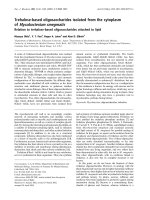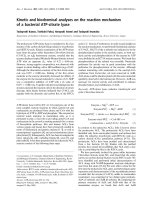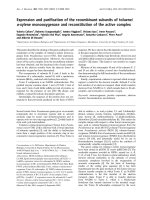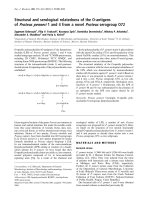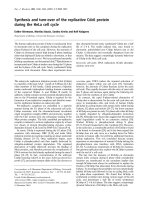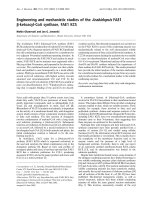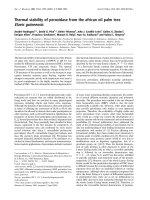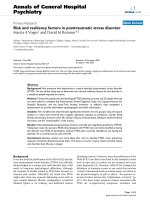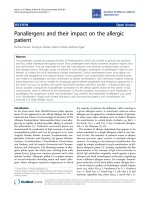Báo cáo y học: "Cancer and kinases: reports from the front line" pptx
Bạn đang xem bản rút gọn của tài liệu. Xem và tải ngay bản đầy đủ của tài liệu tại đây (66.44 KB, 5 trang )
Genome Biology 2006, 7:314
comment
reviews
reports
deposited research
interactions
information
refereed research
Meeting report
Cancer and kinases: reports from the front line
Stephen K Burley
Address: SGX Pharmaceuticals Inc, 10505 Roselle Street, San Diego, CA 92121, USA. Email:
Published: 25 April 2006
Genome Biology 2006, 7:314 (doi:10.1186/gb-2006-7-4-314)
The electronic version of this article is the complete one and can be
found online at />© 2006 BioMed Central Ltd
A report on the Keystone Symposium ‘Cancer and Kinases:
Lessons from the Clinic’, Santa Fe, USA, 14-19 February 2006.
The success of the Bcr-Abl kinase inhibitor imatinib
(Gleevec) in treating chronic myelogenous leukemia (CML)
has provided considerable impetus to the development of
kinase-targeted therapies for solid tumors and hematologi-
cal malignancies. A Keystone Symposium in February on the
challenges of kinase-targeted drug discovery in oncology
brought together an eclectic group of innovators and encom-
passed a broad array of topics in this field.
Identification of potential therapeutic targets
Cancer cells exhibit numerous mutations, many of which are
in protein kinase genes, and one challenge is to distinguish
which of these mutations are actually responsible for malig-
nant transformation and thus might represent therapeutic
targets. Michael Stratton (Wellcome Trust Sanger Institute,
Hinxton, UK) described how high-throughput sequencing of
cancer-cell genomes is being used to construct mutational
profiles of human cancers. He described how somatic muta-
tions acquired during gestation and throughout life culminate
in tumors that bear mutations in oncoproteins and in DNA
repair proteins. Sequencing of around 200 distinct types of
cancer revealed that approximately 50% bear mutations in
protein kinase genes, only a small number of which are
thought to be responsible for malignancy. For colorectal and
gastric cancers, the vast majority exhibit somatic mutations
in kinase genes. Stratton’s conclusion was that sequencing
many examples of each rigorously characterized tumor type
will be needed to permit the statistically significant identifica-
tion of the ‘driver’ mutations that contribute to cancer.
Another approach to identifying protein kinases that might
be therapeutic targets is to determine the effects of suppress-
ing their expression using RNA interference (RNAi). William
Hahn (Dana Farber Cancer Institute, Boston, USA) showed
the power of this technique to suppress specific genes in
mammals such as mice and humans that are not candidates
for conventional mutational screening. The RNAi Consor-
tium, a public-private initiative of which Hahn is a member,
has produced lentiviral vectors encoding RNAs that target
around 20,000 mouse and human genes (four to five vectors
per gene), and which are commercially available from con-
sortium members Sigma-Aldrich (St. Louis, USA) and Open
Biosystems (Huntsville, USA). Hahn is using high-content
imaging to identify modulators of mitosis in a screen of
arrays of cells transformed with lentiviral vectors that sup-
press the expression of individual protein kinases and phos-
phatases. Suppression of many of the kinases in this screen
induces apoptosis, suggesting that they represent potential
therapeutic targets. Unexpected hits include the kinases Yes,
Tie1 and Met, which were not previously known to be
involved in cell-cycle regulation.
Taking the proteomics route to identifying potential kinase
substrates, Richard Polakiewicz (Cell Signaling Technology,
Danvers, USA) described immunoaffinity/mass spectrometric
profiling of tyrosine phosphorylation events in cancer cells,
which has detected around 11,000 distinct phosphotyrosine
sites across some 130 tumors and cancer cell lines. After treat-
ment of seven non-small-cell lung cancer cell lines with the
tyrosine-kinase inhibitor gefitinib (Iressa), to which some
patients with lung cancer appear to respond favorably while
many do not, there was a marked, but non-uniform, reduction
in the levels of tyrosine phosphorylation. This technology has
also been used to screen cell lines derived from patients with
acute myelogenous leukemia (AML), and has revealed
increased phosphorylation of Jak3 kinase substrates.
Many potential inhibitors inhibit multiple kinases, and eluci-
dating the kinase-inhibition profiles of drug candidates will
be necessary to predict their likely side effects. In this
regard, Patrick Zarrinkar (Ambit Biosciences, San Diego,
USA) described an assay system that characterizes a profile
by the displacement of kinases from a solid support through
competition for the ATP binding site. Not surprisingly,
imatinib (specific for Bcr-Abl, cKit, and the PDGF receptor)
and staurosporine (a promiscuous kinase inhibitor), display
radically different kinase-binding profiles, with most clini-
cally relevant kinase inhibitors falling in between. Remark-
ably, even compounds optimized for powerful activity
against one target - in this case the epidermal growth factor
(EGF) receptor - can differ radically in their kinase-
inhibitory profiles. Zarrinkar closed his talk with an account
of how Ambit has used kinase-inhibitory profiling to opti-
mize inhibitors of the receptor tyrosine kinase Flt3 with
activity in a nude mouse xenograft model.
A problem of resistance
As with any drug, resistance against imatinib has emerged as
a therapeutic problem. There are now more than 50 clinically
characterized mutations that contribute to imatinib resis-
tance in CML, some of which predate drug treatment, and
new drugs are being sought to overcome this challenge. SGX
Pharmaceuticals has developed the proprietary FAST (frag-
ments of active structures) platform for the discovery of drug
leads, which is based on X-ray crystallography of small frag-
ments or scaffolds. I described its application to screening
compounds against the ‘wild-type’ Bcr-Abl kinase and the
imatinib-resistant Bcr-Abl Thr315Ile mutant in parallel to
discover and optimize potent third-generation Bcr-Abl
inhibitors. In vitro data show that compounds that inhibit
Bcr-Abl and most of the clinically significant imatinib-resis-
tant forms of this oncoprotein (including Thr315Ile) induce
apoptosis in leukemic cells driven to proliferate by Bcr-Abl
and inhibit phosphorylation of the Bcr-Abl substrate Crkl, but
have no effect on normally dividing cells. SGX anticipates
filing an investigational new drug application in 2007 to
permit clinical development of a third-generation Bcr-Abl
kinase inhibitor for treatment of imatinib-resistant CML.
Charles Sawyers (Howard Hughes Medical Institute and Uni-
versity of California, Los Angeles, USA) described lessons
learned from his studies on resistance to imatinib and from
recent clinical experiences with dasatinib, a second-generation
Bcr-Abl inhibitor. Dasatinib, a dual Src/Bcr-Abl inhibitor, is
active against many of these resistant kinases, with the
important exception of the Thr315Ile mutant. Early clinical
studies with dasatinib show the potential value of close moni-
toring of pharmacokinetic/pharmacodynamic correlates -
which detail the behavior of the drug in the body: these
demonstrated that leukemia patients who experienced only
Src inhibition (without Bcr-Abl inhibition) did not respond
with an amelioration of their cancer. Predictably, there were
also no responses in patients with the Thr315Ile mutation.
Moreover, disease progression was seen in patients who may
have acquired the very same mutation. Sawyers also
reported that in in vitro saturation mutagenesis studies of
Bcr-Abl in the presence of dasatinib, the only imatinib-resis-
tant mutation that emerged was Thr315Ile. In addition, the
dasatinib selection yielded a small number of previously
undescribed resistance mutations that are sensitive to ima-
tinib. Taken together, these results make a case for up-front
combination therapy for CML using agents with non-over-
lapping resistance profiles.
Visualizing drug action
David Piwnica-Worms (Washington University School of
Medicine, St. Louis, USA) described strategies for pathway-
specific molecular imaging in vivo that can be used in both
basic research and clinical studies. He described the use of
micro positron emission tomography (micro PET) combined
with spatially determined expression of mutant forms of
herpes simplex virus 1 thymidine kinase to detect trapped
radiopharmaceuticals in groups of cells bearing the kinase.
For whole-animal in vivo studies, bioluminescent imaging
with firefly luciferase permits spatial mapping of a reporter
gene within small animals such as mice. Applications of
these techniques included imaging drug effects on the degra-
dation of the NFB inhibitor IB␣ in the IKK/NFB pathway
in live mice, which enabled pharmacodynamic correlations
of biochemical effect and drug levels; and imaging of two-
hybrid studies of protein-protein interactions in vivo.
At the single-cell level, Gary Nolan (Stanford University
School of Medicine, Stanford, USA) presented correlations
between kinase activity and single-cell signaling metabolism
in populations of mixed cell types analyzed using flow cytom-
etry. Using monoclonal antibodies to both cell-surface
proteins (to distinguish cell types) and intracellular phospho-
proteins, phosphorylation and activation of the transcription
factor Stat1 could be distinguished in subpopulations of B
lymphocytes and T lymphocytes in a sample of murine
splenocytes stimulated with interferon-␥. After showing this
proof of concept, Nolan demonstrated how the approach pro-
vides insights into stratification of AML patients by examin-
ing the effects of cytokine stimulation of leukemic blast cells
from individual patients on the levels of the phosphorylated
forms of Stat3, Stat5, Stat6, and the kinases p38 and Erk1/2.
Using these ‘signaling maps’, chemotherapy-insensitive
patients with poor prognoses could be readily distinguished
from those patients who did respond to standard chemother-
apy. Such detailed characterizations may ultimately guide the
co-administration of signal-transduction modulators with
conventional chemotherapy to patients with poor prognosis
signaling maps to improve treatment outcome.
Targeting receptor tyrosine kinases
Members of the EGF receptor family have proved important
potential targets for anti-cancer drugs, and several inhibitors
have been approved or are in clinical trials. They include the
monclonal antibody Herceptin (trastuzumab), which targets
the receptor Her, and small-molecule inhibitors. Gary
Pestano (Ventana Medical Systems, Tucson, USA) discussed
the evaluation of tissue-derived diagnostic phosphorylated
314.2 Genome Biology 2006, Volume 7, Issue 4, Article 314 Burley />Genome Biology 2006, 7:314
biomarkers in the EGF receptor pathway and presented the
company’s experiences with biomarker validation in the
context of colorectal cancer progression. Upward and
downward trends of various markers were documented as
colorectal tumors underwent local and then distal metasta-
sis. He presented a case study in which biomarker levels
measured by the company’s proprietary technology
revealed a poor prognosis phenotype in a colorectal tumor
of a Ventana employee, enabling the patient to elect to have
adjuvant combination chemotherapy following radiation
and colostomy.
Janet Dancey (National Cancer Institute, NIH, Bethesda,
USA) described outcomes in clinical trials of EGF receptor
inhibitors. Her receptors, which bind the EGF-like growth
factor heregulin, were inhibited using either antibodies that
target the extracellular portion of the receptor, or small mol-
ecules that target one or more kinase domains, or antisense
oligonucleotides intended to suppress expression of a spe-
cific Her-family gene. Differences were observed in the toxi-
city and efficacy of antibodies versus small molecules that can
be explained, at least in part, in terms of differences in mech-
anism of action, off-target activity, and pharmacokinetic
behavior in vivo. Single-agent treatment of EGF receptor
inhibitors (antibodies or small-molecule inhibitors) gave
modest objective responses in lung, brain, head and neck,
ovarian, esophageal, liver, and colon cancers. Studies of anti-
bodies or small-molecule inhibitors in combination with
cytotoxic chemotherapy or radiation have demonstrated sur-
vival benefits in some cases. Many additional randomized
controlled trials are under way, and a clearer view of the
utility of numerous single-agent and combination approaches
to EGF-receptor-targeted therapy should emerge within the
next two to three years.
Many cancer patients have mutations of EGF receptor genes,
and Daniel Haber (Massachusetts General Hospital and
Harvard Medical School, Boston, USA) presented analyses of
the impact of EGF receptor mutations on individual sensitiv-
ity and resistance to tyrosine-kinase inhibitors. Opening
with an anecdotal report of a Boston woman apparently
cured of lung cancer with gefitinib, a small-molecule tyro-
sine-kinase inhibitor that has proved of very limited efficacy
in most people, his presentation focused on studies of
patients and model systems aimed at understanding why
some patients respond to therapy with gefitinib and others
do not. Most of the patients (40-80%) responding to small-
molecule inhibitors of EGF receptor kinase domains exhibit
kinase-activating mutations or gene amplification. In con-
trast, patients lacking mutations or amplification respond
only rarely (10-15%). When compared with signaling by
wild-type EGF receptors, signaling by mutant EGF receptors
increases phosphorylation of the kinase Akt and the tran-
scription factor Stat5 and downregulates Erk. Exposure of
cells bearing mutant receptors to clinically achievable con-
centrations of small-molecule inhibitors of EGF receptors
leads to apoptosis. Significantly higher drug concentrations
are required to produce apoptosis in the context of the wild-
type receptor. Regrettably, approximately half of the
patients responding well to the small-molecule inhibitors do
so for only a short time (3-6 months), after which relapse
occurs, because the kinase domain has developed a drug-
resistance mutation - Thr790Met, which is analogous to the
imatinib-resistant Thr315Ile mutation in Bcr-Abl.
Mark Sliwkowski (Genentech, South San Francisco, USA) is
examining the EGF receptor family with a view to designing
new antibodies that target the receptor Her2, the target Her-
ceptin. High-resolution X-ray crystallographic structures
have provided detailed insights into Her2 heterodimeriza-
tion and Her2-antibody interactions. These structures
suggest alternative epitopes for targeting with novel antibod-
ies. The Her2 sheddase (Mmp15, a membrane-linked metal-
loprotease) is responsible for cleavage of the extracellular
component of the receptor, and Sliwkowski also described
how resistance to Herceptin may be correlated with Mmp15
cleavage activity, which yields an activated, truncated form
of the receptor lacking the epitope recognized by Herceptin.
This hypothesis is currently being evaluated. Enzyme-kinetic
analyses of Her2 with mutations in the kinase domain have
explained the increased sensitivity of tumors bearing these
mutant receptors to small-molecule inhibitors compared
with tumors bearing a non-mutant receptor. These results
suggest that high doses of small-molecule inhibitors will be
crucial for treating patients with tumors driven to proliferate
by non-mutant Her2.
Flt3 is a receptor tyrosine kinase that is important in leukocyte
development and is being targeted as a possible treatment for
AML. Donald Small (Johns Hopkins University School of
Medicine, Baltimore, USA) described studies on Flt3 in AML
patients. Individuals carrying the internal tandem duplication
mutation in FLT3 have considerably poorer responses to con-
ventional induction chemotherapy with cytarabine and dau-
narubicin (the so-called 7+3 therapy) and correspondingly
poor prognoses. Recent advances in preclinical characteriza-
tion and clinical studies of Flt3 inhibitors were described in
detail. The responses of patients with the internal tandem
duplication mutation to therapy with a single Flt3 inhibitor
are critically dependent on the blood levels of the drug.
Current clinical studies on Flt3 inhibitors focus on relapsed
AML patients who are receiving either high-dose cytarabine or
a combination of mitoxantrone, etoposide and cytarabine.
Ultimately, the best prospects for such inhibitors are likely to
be in the setting of 7+3 induction chemotherapy for newly
diagnosed AML patients with the Flt3 internal tandem dupli-
cation mutation.
Targeting of intracellular kinases
Many different intracellular protein kinases are components
of mitogenic signaling pathways. David Solit (Memorial
comment
reviews
reports
deposited research
interactions
information
refereed research
Genome Biology 2006, Volume 7, Issue 4, Article 314 Burley 314.3
Genome Biology 2006, 7:314
Sloan-Kettering Cancer Center, New York, USA) described
the targeting of the oncogenic kinase B-Raf, a mutant com-
ponent of the Ras-Raf-Mek mitogen-activated protein
kinase (MAPK) cascade, and also discussed how the pres-
ence of B-Raf mutations is correlated with the sensitivity of
tumor cells to Mek inhibitors. Peter Lamb (Exelixis, San
Francisco, USA) outlined high-throughput approaches to the
discovery of phosphatidylinositol 3-kinase (PI 3-kinase)
pathway inhibitors. An Exelixis compound (XL418) that
inhibits Akt and P70S6 kinase blocks the growth of tumor
xenografts in mice in a regime of either continuous or twice-
weekly dosing. Combinations of XL418 with EGF-receptor
inhibitors display synergy in tumor models, with dramatic
increases in levels of apoptosis. Inhibitors of PI 3-kinase,
Mek, and casein kinase 2 (CK2) were also described in a whirl-
wind tour of preclinical studies of various multi-targeted com-
pounds. Lamb concluded that targeting multiple points
within a given signal transduction pathway shows clear evi-
dence of increased efficacy in model systems, which suggests
various rational combinations of drugs for clinical interven-
tion in the PI 3-kinase pathway.
Gary Gilliland (Harvard Medical School and Howard
Hughes Medical Institute, Boston, USA) described the role
of the protein kinase Jak2 in myeloproliferative disease
(MPD), including diseases such as polycythemia vera,
myelofibrosis, and essential thrombocytopenia, which have a
cumulative prevalence of 80,000-100,000 in the US popula-
tion. Gilliland also described the Harvard Myeloproliferative
Study and presented the results of high-throughput sequenc-
ing of DNA from MPD patients, which frequently revealed
an acquired somatic mutation, Val617Phe, in Jak2. This
mutation occurs in the JH2 region of the polypeptide chain
and renders Jak2 constitutively active, leading to uncon-
trolled proliferation of myeloid cells (leukocytes other than
lymphocytes, megakaryocytes, and erythrocyte precursors)
in response to stimulation with cytokines such as erythropoi-
etin. Some individuals bearing the Jak2 Val617Phe mutation
have excelled as athletes - in one celebrated case, achieving
an Olympic gold medal in cross-country skiing - because of
the advantage conferred by a ‘naturally’ elevated hematocrit.
Competitors with normal Jak2 would have to resort to blood
doping to achieve the same end. Gilliland discussed how the
preclinical development of Jak2 inhibitors will be facilitated
by the use of murine models of polycythemia vera.
Focusing on another pathway, Helen Piwnica-Worms (Wash-
ington University School of Medicine and Howard Hughes
Medical Institute, St. Louis, USA) characterized the involve-
ment of the Cdc25A/Chk1 cell-cycle regulatory pathway in
normal and tumor cells. Two of the three mitotic protein phos-
phatases, Cdc25A and Cdc25B, are overproduced in a wide
variety of human cancers. Phenotypic studies in Cdc25 knock-
out mice show that global inhibition of Cdc25 will almost cer-
tainly cause gastrointestinal toxicity in humans. Therefore,
selective Cdc25 inhibition will probably be required for
cancer therapy. Alternatively, ubiquitin-mediated degradation
of Cdc25A could be induced by inhibiting its phosphoryla-
tion by the kinase Chk1. Piwnica-Worms described a phase 1
clinical trial in patients with solid tumors that is currently
under way with the Chk1 kinase inhibitor 7-hydroxyl-stau-
rosporine (UCN-01, a natural metabolite from a Strepto-
myces species), in combination with irinotecan, an approved
topoisomerase 1 inhibitor used for the treatment of various
cancers. Efforts are currently under way to understand the
basis of the effects of UCN-01 effects in patients by analyzing
the biology and biochemistry of signal transduction in the
tumor cells.
Future prospects for kinase-targeted therapies
The final session of the conference was devoted to a free-
ranging discussion of future directions in kinase-targeted
cancer therapy. Paul Workman (Cancer Research UK,
Sutton, UK) discussed drugging the cancer ‘kinome’ - all the
kinases implicated in a given cancer - via optimization of
combination therapies. Workman described the biological
rationale underlying combination therapy for cancers, any
one of which will have an estimated five to ten genetic
abnormalities with perhaps two or more of these being criti-
cal for tumor growth and metastasis. Experience with
inhibitors of PI 3-kinase and protein kinase B, both of which
are en route to the clinic, were presented. Finally, the ratio-
nale for targeting the protein-folding chaperone Hsp90 as a
means of achieving the equivalent of inhibiting multiple
kinases simultaneously by interfering with their folding was
discussed.
Kenneth Bair (Chiron Corporation, Emeryville, USA) con-
cluded the meeting by presenting new paradigms for kinase
inhibitor development. Offering the drug-hunter’s point of
view, Bair emphasized the importance of the early availability
of X-ray structures (including co-crystal structures), multiple
chemical frameworks, or scaffolds, for potential lead com-
pounds, and cell-based assays and animal disease models.
Lessons have been learned from CHIR-285 and CHIR-265,
kinase inhibitors developed by Chiron. CHIR-285 inhibits at
least ten distinct protein kinases, including growth factors
and angiogenic factors, and has potent activity against more
than half a dozen tumor types in xenograft models. CHIR-265
is a more focused inhibitor of mutant B-Raf and a modest
number of other targets. Commenting on kinase inhibitor
selectivity profiles, Bair was of the opinion that clinical trial
design tends to be simpler for the more selective kinases. He
also described how Chiron’s database of kinase X-ray struc-
tures and kinase selectivity profiles has been combined with
150,000 compounds comprising the Chiron kinase-focused
chemical library. Computational tools are being used to
mine available data to identify lead scaffolds and compounds
likely to exhibit the desired activity profile against a desired
set of kinase targets. Subsequently, fewer than 10,000 com-
pounds are evaluated for activity against the desired targets
314.4 Genome Biology 2006, Volume 7, Issue 4, Article 314 Burley />Genome Biology 2006, 7:314
and prioritized, permitting a small set of compounds from a
single scaffold to be taken forward for hit-to-lead optimiza-
tion and subsequent optimization of drug-like properties.
This exciting, wide-ranging meeting provided an up-to-the
minute view of methodological and technical approaches to
the challenges of discovering and developing new chemical
entities that target protein kinases implicated in cell-cycle
control, apoptosis, tumorigenesis and metastasis. Given that
CML is one of only a very few malignancies caused by a
single genetic lesion, namely the Philadelphia chromosomal
translocation, the focus on targeted therapies should not be
absolute. When this meeting reconvenes two years from
now, we should see growing evidence of the benefits of com-
bining targeted kinase inhibitors with one another, with
other targeted therapies (such as Hsp90 inhibitors), and
with cytotoxic antitumor therapies in the enormous number
of multi-genetic-hit cancers represented by the acute
leukemias, lymphomas, and solid tumors.
comment
reviews
reports
deposited research
interactions
information
refereed research
Genome Biology 2006, Volume 7, Issue 4, Article 314 Burley 314.5
Genome Biology 2006, 7:314

